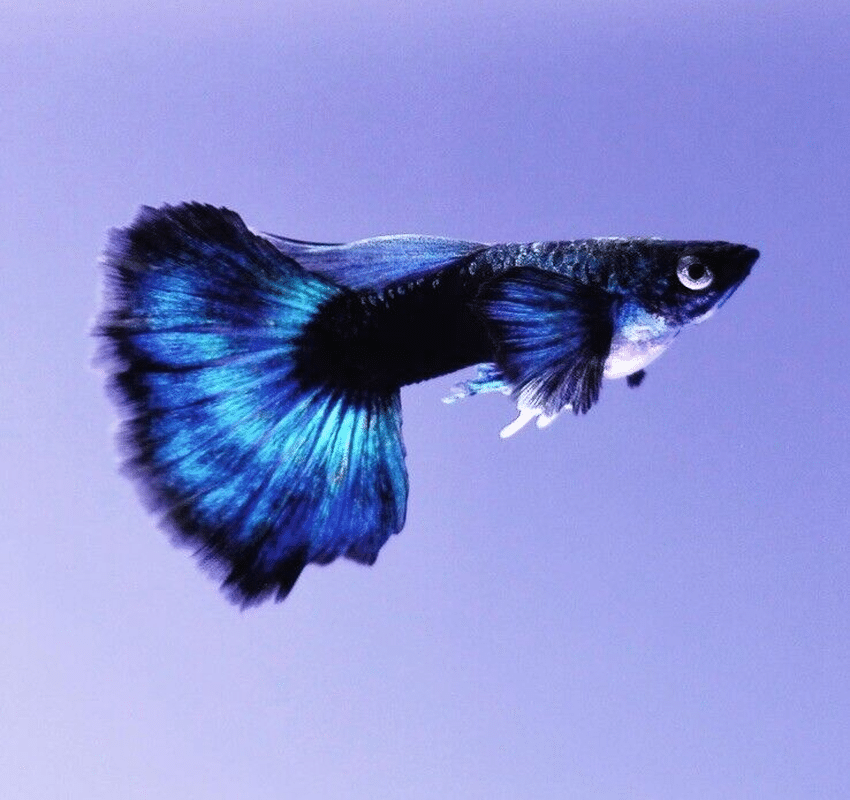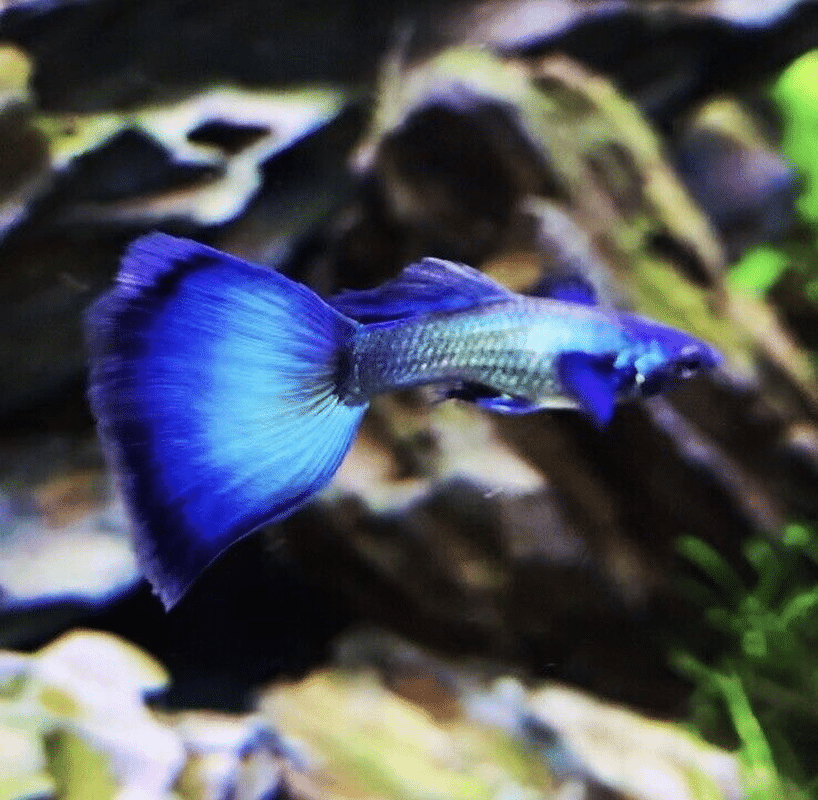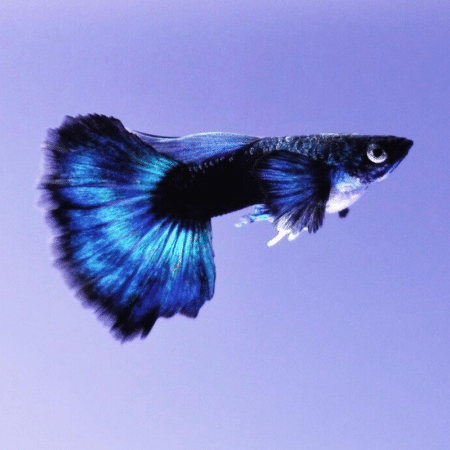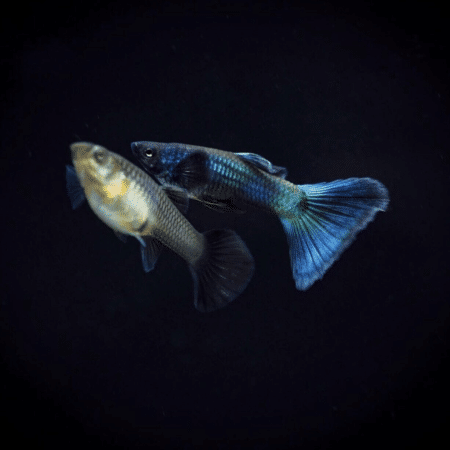Guppy Poecilia Ret in Pairs Blue Moscow Guppies (1 Male + Female), Stunning Freshwater Fish, Thrive with Easy Care, Ideal for Beginners and Aquarium Maintenance Lovers, Beautiful Companions for Your Aquatic Home
£25.49 Original price was: £25.49.£21.29Current price is: £21.29.
Welcome these beautiful Blue Moscow Guppies (Poecilia reticulata) into your aquarium! This stunning pair includes one male and one female, perfect for breeding. Their vibrant colors and elegant movements make them peaceful companions in community tanks, thriving with proper care.
88 in stock
Species Introduction
The Guppy, scientifically known as Poecilia reticulata, is one of the most popular freshwater fish species in the aquarium hobby. Native to the warm waters of South America, particularly in regions such as Venezuela and Trinidad, guppies are renowned for their vibrant colors and lively personalities. The Blue Moscow Guppy variant is particularly striking, characterized by its deep blue coloration and elegant fin structure, making it a favorite among aquarists. Guppies are small fish, typically reaching a maximum length of around 6 cm, and they thrive in a variety of freshwater environments, making them an excellent choice for community tanks. Their adaptability and peaceful nature have earned them the title of “best beginner fish,” as they are forgiving of minor water quality fluctuations and can coexist harmoniously with many other species.
Care Requirements Dashboard
Essential Care Guide for Your Guppy Poecilia Ret in Pairs Blue Moscow Guppies (1 Male + Female)
| Optimal Living Conditions | |
|---|---|
| Water Temperature | 24-27°C (75-81°F) |
| pH Level | 6.5-7.5 |
| Water Hardness | 4-12 dKH |
| Minimum Tank Size | 80L (20 gal) |
| Salinity | Freshwater |
| Care Level | Beginner Friendly |
✓ Care Level: Easy
Tank Size: Minimum 20 liters (5 gallons)
Water Parameters: pH 6.8-7.8, Temperature 22-28 °C (72-82 °F), Hardness 5-20 dGH
Natural Behavior & Temperament
Guppies are known for their active and playful behavior, often swimming in schools and exploring their environment. They exhibit a peaceful temperament, making them ideal for community tanks. In a well-planted aquarium, guppies will thrive, utilizing plants for shelter and breeding. Their social nature means they enjoy the company of their own kind, so it is recommended to keep them in groups. Male guppies are particularly known for their vibrant displays during courtship, showcasing their beautiful colors and patterns to attract females. This behavior not only adds visual interest to the aquarium but also highlights the importance of providing a suitable environment that encourages natural behaviors.
Tank Setup Guide
Creating an ideal environment for your Blue Moscow Guppies is essential for their health and happiness. Start with a minimum tank size of 20 liters (5 gallons) to provide ample swimming space. The substrate can be fine gravel or sand, which allows for easy planting of aquatic plants. Incorporate live plants such as Java Moss, Anubias, or Hornwort, which not only enhance the aesthetics of the tank but also provide hiding spots for fry and reduce stress levels. Decorations like driftwood and rocks can create territories and add to the natural look. Ensure that the tank is well-filtered and maintain a gentle water flow to mimic their natural habitat. Proper lighting is also crucial; a moderate light cycle of 10-12 hours a day will promote plant growth and keep your guppies active.
Water Quality Management
Water Parameter Notice
Maintaining optimal water quality is critical for the health of your guppies. Aim for a pH level between 6.8 and 7.8, with a temperature range of 22-28 °C (72-82 °F). Regular water changes of 25-30% every two weeks will help keep ammonia and nitrate levels low. Test your water regularly using a reliable aquarium test kit to monitor hardness, pH, and temperature. Guppies are sensitive to poor water conditions, and fluctuations can lead to stress and illness. A well-maintained aquarium not only benefits your guppies but also enhances the overall beauty of your aquatic environment.
Feeding & Nutrition
Guppies are omnivorous and thrive on a varied diet. A high-quality flake food specifically formulated for freshwater fish should form the basis of their diet. Supplement this with frozen or live foods such as brine shrimp, daphnia, and bloodworms to enhance their color and vitality. Feed your guppies 2-3 times a day, providing only as much food as they can consume in 2-3 minutes to prevent overfeeding and maintain water quality. It is also beneficial to include vegetable matter in their diet, such as blanched spinach or spirulina flakes. Proper nutrition is essential for their growth, breeding success, and overall well-being.
Compatibility Guide
✓ Peaceful Aquarium Fish
Guppies are generally peaceful and can coexist with a variety of other species. Ideal tank mates include other small, non-aggressive fish such as neon tetras, rasboras, and corydoras catfish. Avoid larger or aggressive fish that may view guppies as prey. When planning your community tank, consider the size and temperament of potential tank mates to ensure a harmonious environment. A well-balanced community tank will not only enhance the beauty of your aquarium but also promote the health and happiness of all its inhabitants.
Health & Wellness
Keeping your guppies healthy requires attention to their environment and diet. Common health issues include fin rot, ich, and swim bladder disease. Regularly check for signs of illness, such as changes in behavior, loss of appetite, or visible lesions. Quarantine any new fish before introducing them to your main tank to prevent the spread of disease. Maintaining water quality and providing a balanced diet are key preventive measures. If you notice any health issues, consult a veterinarian specializing in fish or seek advice from experienced aquarists to ensure your guppies receive the appropriate care.
Breeding Information
Guppies are prolific breeders, and breeding them can be a rewarding experience. To encourage breeding, ensure that your tank has plenty of hiding spots and plants for the fry to hide from adult fish. A ratio of one male to two or three females is recommended to reduce stress on the females. When ready to breed, the male will display courtship behavior, and after mating, the female will carry the fertilized eggs for about 28 days before giving birth to live fry. It is essential to separate the fry from the adults shortly after birth to prevent them from being eaten. Feed the fry a diet of finely crushed flakes or specialized fry food to ensure their healthy growth.
Acclimation Process
Introducing your new guppies to their aquarium requires a careful acclimation process to minimize stress and ensure a smooth transition. Begin by floating the sealed bag containing the guppies in the aquarium for about 15-20 minutes to equalize the temperature. After this, gradually introduce small amounts of tank water into the bag every 5 minutes for about 30 minutes. This process helps the guppies adjust to the water parameters in their new home. Once acclimated, gently release the guppies into the tank using a net to avoid adding any transport water that may contain harmful substances.
Long-term Care
The lifespan of guppies typically ranges from 2 to 5 years, depending on their care and environment. To ensure a long, healthy life for your Blue Moscow Guppies, maintain optimal water conditions, provide a balanced diet, and monitor their health regularly. Regular water changes, tank maintenance, and observing their behavior will help you catch any potential issues early. As they grow, you may need to upgrade their tank size or adjust their environment to accommodate their needs. Keeping a close eye on their growth and health will enhance your experience as an aquarist and contribute to a thriving aquatic community.
Natural Habitat Recreation
To create a natural habitat for your Blue Moscow Guppies, consider replicating their native environment as closely as possible. In the wild, guppies inhabit shallow streams, ponds, and marshes with plenty of vegetation. Incorporate live plants, such as floating plants and dense foliage, to mimic their natural surroundings. Use driftwood and rocks to create hiding spots and territories. Ensure that your aquarium has a gentle current to simulate their natural habitat. This setup not only enhances the aesthetic appeal of your aquarium but also promotes the well-being of your guppies by providing them with a stress-free environment.
Seasonal Care Adjustments
As seasons change, so do the needs of your guppies. During warmer months, ensure that the water temperature does not exceed 28 °C (82 °F), as higher temperatures can stress your fish. Use fans or chillers if necessary to maintain a stable environment. In cooler months, monitor the temperature closely and consider using a heater to keep the water within the optimal range. Adjust the lighting duration based on seasonal changes to mimic natural daylight cycles, which can influence breeding behaviors and overall health. Keeping an eye on these seasonal changes will help you provide the best care for your guppies.
Expert Tips
For those looking to enhance their guppy-keeping experience, consider joining local aquarist clubs or online forums where you can share experiences and gain insights from other enthusiasts. Regularly attending workshops or webinars can also provide valuable information on advanced care techniques, breeding practices, and tank setups. Experimenting with different types of food can lead to improved coloration and health in your guppies. Additionally, maintaining a diverse community tank with compatible species will create a vibrant and dynamic environment that showcases the beauty of your guppies and their aquatic companions.
Troubleshooting
Despite your best efforts, you may encounter challenges while caring for your guppies. Common issues include signs of stress, such as hiding, lethargy, or loss of appetite. If you notice these behaviors, check your water parameters immediately and perform a water change if necessary. If you suspect illness, isolate the affected fish in a quarantine tank and consult a knowledgeable source for treatment options. Understanding the common problems associated with guppy care will help you address issues promptly and ensure the well-being of your aquatic friends.
Scientific Background
The guppy belongs to the family Poeciliidae, which includes several other popular aquarium fish. They are an important species for ecological studies due to their adaptability and rapid reproduction rates. Research into guppy genetics has contributed to our understanding of evolutionary biology and sexual selection. Conservation efforts are essential to protect wild guppy populations from habitat destruction and pollution. By keeping guppies in aquariums, hobbyists can help raise awareness about the importance of preserving aquatic ecosystems and the species that inhabit them.
Advanced Care Techniques
For experienced aquarists looking to take their guppy care to the next level, consider exploring selective breeding to enhance specific traits, such as color and fin shape. Keeping detailed records of breeding pairs and their offspring can help in understanding genetics and improving your breeding program. Additionally, experimenting with different tank setups, such as biotope aquariums that mimic specific ecosystems, can provide a unique challenge and enhance the overall experience of keeping guppies. Advanced filtration systems and automated monitoring equipment can also help maintain optimal water conditions with minimal effort.
Water Quality Parameters
Optimal Range
24-27°C
6.5-7.5
0 ppm
Caution Zone
22-24°C or 27-29°C
6.0-6.5 or 7.5-8.0
0.25-0.5 ppm
Danger Zone
<22°C or >29°C
<6.0 or >8.0
>0.5 ppm
Monitoring Tip: Test water parameters weekly and perform regular water changes to maintain optimal conditions for your aquatic friends!
Frequently Asked Questions
Q: What tank size is required for Blue Moscow Guppies?
Blue Moscow Guppies thrive best in a tank that is at least 40 litres (10 gallons) for a pair. This size allows them ample swimming space and helps maintain stable water parameters. A larger tank is preferable if you plan to add more guppies or other tank mates. It is crucial to provide sufficient room to prevent overcrowding, which can lead to stress and aggressive behaviour. Additionally, ensure the tank is well-planted and includes hiding spots to make the guppies feel secure and comfortable in their environment.
✓ Expert Tip
Consider using a larger aquarium if you wish to breed your guppies or keep them with other species. This will help maintain water quality and reduce territorial disputes.
Q: What water parameters do Blue Moscow Guppies require?
Blue Moscow Guppies prefer water with a temperature between 24-28°C (75-82°F), a pH level of 6.8-7.8, and a hardness of 5-19 dGH. Regular testing of these parameters is essential as fluctuations can affect their health. Use quality water conditioners to remove harmful chemicals from tap water before adding it to the tank. Additionally, perform regular water changes (approximately 20-25% weekly) to maintain optimal water quality, which is vital for preventing diseases and ensuring the well-being of your aquatic companions.
✓ Expert Tip
Invest in a reliable water testing kit to monitor parameters regularly and ensure your guppies thrive in a stable environment.
Q: How often should I feed Blue Moscow Guppies?
Blue Moscow Guppies should be fed small amounts 2-3 times a day. A varied diet is essential for their health; consider high-quality flake food, frozen or live foods such as brine shrimp, and vegetable matter like spirulina. Overfeeding can lead to poor water quality, so monitor their intake and adjust accordingly. Remove uneaten food promptly to prevent decay and maintain water clarity. This feeding routine will help promote vibrant colours and overall vitality in your guppies.
✓ Expert Tip
Rotate between different food types to provide a balanced diet and enhance the colouration of your guppies.
Q: What are the best tank mates for Blue Moscow Guppies?
Blue Moscow Guppies are generally peaceful and can coexist with various community fish. Ideal tank mates include small tetras, rasboras, and other non-aggressive species like Corydoras catfish. Avoid larger or more aggressive fish that may see guppies as food or threaten their peaceful nature. Ensure that all fish friends are kept in appropriate groups and ratios to reduce stress and aggression in the tank. It is also advisable to maintain a well-planted tank to provide hiding spaces for all species.
✓ Expert Tip
Research compatibility before introducing new fish to ensure a harmonious community and maintain a stress-free environment.
Q: How do I properly acclimatise Blue Moscow Guppies to my aquarium?
Acclimatising your Blue Moscow Guppies is crucial for their health. Start by floating the sealed bag in your aquarium for about 15-20 minutes to equalise the temperature. Then, gradually mix a small amount of tank water into the bag every 5-10 minutes for about an hour. This process helps the guppies adjust to the new water parameters. Finally, use a net to transfer the guppies into the tank, discarding the bag water to prevent contaminants from entering your aquarium. This gradual approach minimises stress and enhances their chances of thriving.
✓ Expert Tip
Always monitor your guppies for signs of stress after acclimatisation, such as erratic swimming or hiding, and ensure they adapt well to their new environment.
Q: What are the signs of healthy Blue Moscow Guppies?
Healthy Blue Moscow Guppies exhibit vibrant colours, clear eyes, and active swimming behaviour. They should show no signs of distress, such as clamped fins or lethargy. Additionally, observe their appetite; a healthy guppy will eagerly feed during meal times. Regularly check for any visible signs of disease, such as spots or lesions, and monitor their behaviour for any unusual patterns. Keeping a close eye on your fish friends will help you identify any health issues early and address them promptly.
✓ Expert Tip
Consider keeping a journal to track your guppies’ health and behaviour, which can help you spot changes over time.
Q: How do I successfully breed Blue Moscow Guppies?
Breeding Blue Moscow Guppies is relatively straightforward. To encourage breeding, ensure a suitable environment with stable water parameters and a well-planted tank. Introduce a male and female pair, as females can give birth to up to 30 fry every 3-4 weeks. Provide plenty of hiding spaces for the fry to avoid predation from adult guppies. After birth, remove the adults or use a breeding trap to protect the young until they grow larger and can be safely integrated into the main tank. Regular feeding with high-quality fry food will support their growth.
✓ Expert Tip
Keep a separate breeding tank if you wish to increase your fry’s survival rate and simplify care for both adults and young.
Q: What temperature should I maintain for Blue Moscow Guppies?
Blue Moscow Guppies thrive in water temperatures ranging from 24-28°C (75-82°F). It’s essential to maintain a stable temperature, as fluctuations can lead to stress and health issues. Use a reliable aquarium heater and thermometer to monitor and regulate the temperature effectively. Ensure that the heater is positioned properly to prevent overheating and always check the manufacturer’s guidelines for the appropriate wattage based on your tank size. Regular monitoring will keep your guppies comfortable and healthy.
✓ Expert Tip
Consider investing in a heater with a built-in thermostat for optimal temperature control.
Q: How long do Blue Moscow Guppies typically live in captivity?
Blue Moscow Guppies typically have a lifespan of 2-3 years in captivity, provided they are kept in optimal conditions. Factors such as water quality, diet, tank mates, and overall care significantly influence their longevity. Regular water changes, a balanced diet, and monitoring for any signs of illness will enhance their quality of life and potentially extend their lifespan. By providing a stable and healthy environment, you can enjoy the beauty of your guppies for many years.
✓ Expert Tip
Keep track of their health and behaviour to identify any changes that may indicate stress or illness.
Q: What type of substrate is most suitable for Blue Moscow Guppies?
Blue Moscow Guppies thrive in a substrate that allows for plant growth and provides a natural environment. Fine gravel or sand is ideal as it is gentle on their delicate fins and allows for easy planting of aquatic plants. Avoid sharp substrates that could potentially harm your guppies. Additionally, a well-structured substrate promotes beneficial bacteria growth, which aids in maintaining water quality. Consider layering your substrate with nutrient-rich soil underneath for optimal plant health.
✓ Expert Tip
Regularly clean the substrate during water changes to remove debris and prevent water quality issues.
Q: What behavioural patterns should I expect from Blue Moscow Guppies?
Blue Moscow Guppies exhibit a lively and social behaviour, often seen swimming in groups or exploring their surroundings. They are known to be curious fish, frequently interacting with their environment, including plants and decorations. Males may display territorial behaviour, especially during mating seasons, but generally, they are peaceful. Providing hiding spots and plants can help reduce any aggressive tendencies. Monitoring their behaviour will also help you identify any signs of stress or illness, ensuring a healthy and thriving community.
✓ Expert Tip
Observe your guppies regularly to become familiar with their normal behaviour, making it easier to spot any changes indicative of stress or illness.
Q: How can I prevent common diseases in Blue Moscow Guppies?
Preventing diseases in Blue Moscow Guppies largely revolves around maintaining optimal water quality and providing a stress-free environment. Regular water changes, maintaining stable water parameters, and a balanced diet are key components of disease prevention. Quarantine new fish before introducing them to your main tank to avoid potential illness spread. Additionally, monitor for signs of stress or disease, such as changes in behaviour or appearance, and address any issues immediately. Providing a well-planted tank with hiding spots will also help reduce stress.
✓ Expert Tip
Consider using a high-quality aquarium salt to help prevent certain diseases and promote overall health.
Q: What lighting conditions do Blue Moscow Guppies prefer?
Blue Moscow Guppies prefer moderate lighting that mimics their natural habitat. Bright light can cause stress and encourage algae growth, while low light may hinder plant growth. A good balance is to provide around 10-12 hours of light daily, using LED or fluorescent lights. Consider adding floating plants to diffuse the light and create shaded areas, which will help your guppies feel secure. Regularly adjust the lighting based on plant needs and monitor how your guppies respond to changes in light levels.
✓ Expert Tip
Use a timer to maintain consistent lighting schedules, which helps regulate the circadian rhythms of your guppies.
Q: How do I recognise stress in Blue Moscow Guppies?
Recognising stress in Blue Moscow Guppies is crucial for their well-being. Signs of stress may include erratic swimming, hiding excessively, clamped fins, or loss of appetite. Changes in colouration, such as fading or darkening, can also indicate stress. Additionally, if your guppies are frequently darting around the tank or displaying signs of aggression, it may be a sign of discomfort. If you observe any of these behaviours, assess water quality, tank mates, and environmental factors to identify and address the source of stress promptly.
✓ Expert Tip
Create a peaceful environment with plenty of hiding spots and plants to help reduce stress levels in your guppies.
Q: What natural habitat conditions should I replicate for Blue Moscow Guppies?
Blue Moscow Guppies are native to freshwater environments, typically found in slow-moving waters with plenty of vegetation. To replicate their natural habitat, create a well-planted tank with floating and rooted plants, providing both cover and foraging opportunities. Use driftwood and rocks to create hiding spots. Additionally, ensure the water is clean and well-filtered, mimicking the soft, slightly acidic conditions of their native waters. Maintaining a stable environment will contribute significantly to their health and happiness.
✓ Expert Tip
Consider using a substrate rich in nutrients for plants to thrive, enhancing the overall aesthetics and health of your aquarium.


















Emily Roberts (verified owner) –
I recently purchased a pair of Blue Moscow Guppies (1 Male + 1 Female), and I couldn’t be more thrilled! As a passionate aquarium hobbyist, I’m always on the lookout for unique fish, and these guppies have truly impressed me with their vibrant colors and lively personalities. After about two weeks of having them in my 20-gallon tank, I’ve observed how well they adapt. They swim beautifully, exploring every corner of their new home, and engaging in charming little dances together.
These guppies are not just visually stunning; they are also very hardy fish that have been thriving without any signs of stress. I did compare them to some other guppy varieties I’ve owned, and the Blue Moscow Guppies stand out for their striking coloration and active behavior. One small concern is that they are a bit more delicate than some other guppy types, so make sure to maintain stable water conditions.
Overall, I highly recommend these guppies for both new and experienced fish parents—if you want an eye-catching centerpiece for your aquarium, these are the ones! Plus, they arrive well-packaged and healthy, which shows the seller’s commitment to fish welfare. I’m definitely planning to get more soon!
Emily Carter (verified owner) –
I recently purchased the Blue Moscow Guppies (1 male + 1 female) and I couldn’t be happier with my decision! These freshwater fish are not only stunning with their vibrant blue colors, but they also have such a lively personality. After a week in my 20-gallon community tank, they’ve settled in beautifully and seem to thrive. It’s been a joy to watch them interact and swim around! Compared to other guppy varieties I’ve kept, the Blue Moscow seems to be more resilient and less prone to stress.
I feed them a high-quality flake food and they eagerly come to the surface every time the feeding time rolls around. It’s clear they’re healthy and quite happy, which is my top priority as a caring fish parent.
I did notice that they appreciate some plants for cover, so I’d recommend adding some to your aquarium if you haven’t already. If you’re a beginner or even an experienced aquarist looking to add some flair to your tank, I highly recommend these little beauties. They bring life and color, and their easy care requirements make them a fantastic choice for anyone! I’ll definitely be looking to buy more in the future!